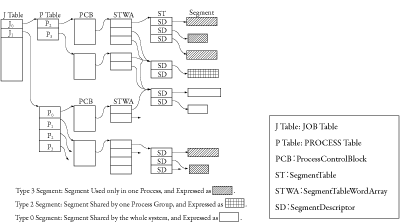NEC announced ACOS-4 (Advanced Comprehensive Operating System-4) in May 1974 and started shipping it in October 1975.
ACOS-4 was developed with a focus on flexibility and expandability for responding to the latest technologies and advancing architecture and credibility in increasing the availability of the system, while maintaining the legacy and compatibility of software assets with NEAC-series 2200 users. It was installed in small-to-medium machines: ACOS System 300 and System 350, and medium-to-large machines: System 400, System 450 and System 500.
Features of the adopted architecture and of major functions were as follows:
1.Features of the Architecture
(1) “Process” was basic control unit, the CPU hardware performed process switching, and semaphore was used as the means of synchronization and communication between processes.
(2) Implemented multiple virtual memory which was based on “segment” - that had logical significance -, and provided an independent space for each process. “Segmentation” increased ease of use and reliability, and achieved memory protection by segment attributes.
(3) Implemented a reentrant routine, and provided a call-stack control function that enhanced the memory protection function through hardware.
(4) Equipped an indirect addressing mechanism that enabled fast execution of one statement of a high-level instruction with a few machine instructions, as well as powerful decimal arithmetic instructions and character string instructions.
(5) An I/O processor that was independent from the instruction execution mechanism managed the schedule for executing channel programs to achieve efficient I/O control.
(6) Implemented an advanced anomaly detection function that increased the reliability of the system and achieved early detection of program errors and program-runaway protection.
2.Features of the Functions
(1) Emulation system
The OS was equipped with an emulation system in order to operate object programs, source programs and file media for the existing NEAC-series 2200 on systems 300/400/500, without modifying them.
The OS was equipped with an emulation system in order to operate object programs, source programs and file media for the existing NEAC-series 2200 on systems 300/400/500, without modifying them.
(2) Message management for controlling communication between terminals and the application programs
- The OS facilitated programming by having messages transmitted/received to/from a software mailbox, instead of having the user program directly transmit/receive messages to/from the terminal, while maintaining synchronization.
- The mailbox had a hierarchical structure to ensure flexibility and versatility of connection and configuration.
- Introduced the concept of virtual network to enable unified control of various networks ranging from a simple network consisting of a single terminal to a complex network containing other computers.
(3) Databases ADBS/DDBS compliant with CODASYL specifications
The OS supported a high-speed general-purpose database management system, ADBS (Advanced Data Base System), which complied with the CODASYL standard. ADBS was a network-type database in which a data structure was defined, and data stored in a virtual storage organization file (VSAS: Virtual Storage Access System) of ACOS-4 were accessed based on the data structure. DDBS (Descriptor Data Base System) was a database that allowed access to existing standard organization files and VSAS organization files based on control information with which the relationship between files and between records was defined, and complied with the language specifications established by CODASYL.
The OS supported a high-speed general-purpose database management system, ADBS (Advanced Data Base System), which complied with the CODASYL standard. ADBS was a network-type database in which a data structure was defined, and data stored in a virtual storage organization file (VSAS: Virtual Storage Access System) of ACOS-4 were accessed based on the data structure. DDBS (Descriptor Data Base System) was a database that allowed access to existing standard organization files and VSAS organization files based on control information with which the relationship between files and between records was defined, and complied with the language specifications established by CODASYL.
(4) Support for high-level functions of programming languages and enhancement of nonprocedural languages
The OS enabled processing of programming languages such as COBOL, which had various functions including classification merging and database processing, FORTRAN, which had all of the language functions of JIS standard 7000, HPL, which was a high-level language for creating a system program, RPG, NAL (Assembler), GMP (Generalized Macro Processor) and NL/II (Non Programmer Language/II).
The OS enabled processing of programming languages such as COBOL, which had various functions including classification merging and database processing, FORTRAN, which had all of the language functions of JIS standard 7000, HPL, which was a high-level language for creating a system program, RPG, NAL (Assembler), GMP (Generalized Macro Processor) and NL/II (Non Programmer Language/II).



